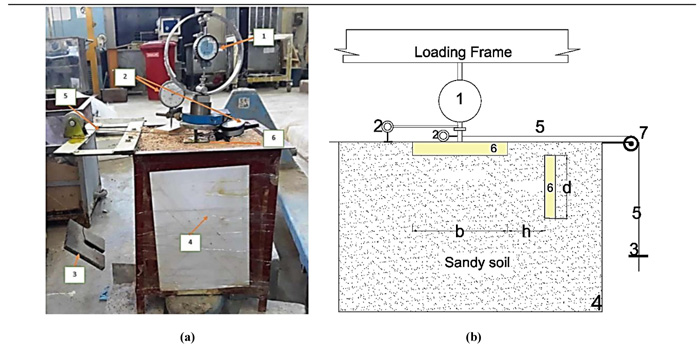RESEARCH ARTICLE
Experimental Investigation of Skirt Footing Subjected to Lateral Loading
Faris Waleed Jawad1, Abbas Fadhil Ibrahim Al-Ameri2, *, Azhar Sadiq Yasun3
Article Information
Identifiers and Pagination:
Year: 2019Volume: 13
First Page: 20
Last Page: 25
Publisher ID: TOCIEJ-13-20
DOI: 10.2174/1874149501913010020
Article History:
Received Date: 6/12/2018Revision Received Date: 14/1/2019
Acceptance Date: 30/1/2019
Electronic publication date: 28/02/2019
Collection year: 2019

open-access license: This is an open access article distributed under the terms of the Creative Commons Attribution 4.0 International Public License (CC-BY 4.0), a copy of which is available at: (https://creativecommons.org/licenses/by/4.0/legalcode). This license permits unrestricted use, distribution, and reproduction in any medium, provided the original author and source are credited.
Abstract
Background:
The skirt foundation is one of the powerful types of foundations to resist the lateral loads produced from natural forces, such as earthquakes and wind action, or from the type of structures, such as oil platforms and offshore wind turbines.
Objective and Methodology:
This research experimentally investigated the response of skirted footing resting on sandy soil of different states to lateral applications of loads on a small-scale physical model manufactured for this purpose. The parameters studied are the distance between the footing and the skirt and its depth.
Results and Conclusion:
The results show that the presence of the skirt behind the footing loads to an increase in bearing load and a reduction in the lateral movement whereas the skirt near or adjacent to the footing edge causes maximum increases in bearing load and reduction in lateral movement, for skirted footing. The ratio between the wall distance and the width of the footing has no effect when it is greater than one. On the other hand, the state of the soil influences the bearing load and lateral movement with different ratio of wall distance and wall depth to the width of the footing, especially when the wall distance to the footing width is less than one and the state of the soil has no effect on the bearing load and lateral movement when the ratio is more than one.
1. INTRODUCTION
Structural skirts can be considered walls fixed to the outer edges of shallow foundations to improve their overall bearing capacities. These walls are considered obstructions in the design and analysis of shallow foundations. Many engineering designs of foundations satisfy the requirements for stability of the vertical load, especially for shear strength requirements, but may fail to bear the settlement and laterals loads that come from superstructures or other structures. For this purpose, skirted foundations are introduced as a solution to increase the resistance of shallow foundation to vertical and lateral loads, in addition, to reduce the total settlement and control the differential settlement. In general, this type of foundation has different applications in marine and offshore structures as a foundation for structures, gravity-based loadings or as a part of the foundation system at the circumference or perimeter and edges of the structures subjected to pullout or jacket loadings.
The existence of wall influences the bearing capacity of the footing, whose behavior in this case can be considered as a skirted foundation in which a structural skirt is located at one or more sides of the footing [1-4].
In general, the use of a skirt at the edge of foundations improves the bearing capacity of the footing against vertical and lateral loads as well as improves load settlement curves during loading [5-8]. In other words, the shear strength, stiffness, and elasticity of the footing and supporting soils are improved through this method [6].
The performance of the foundation was elaborated experimentally and numerically by Amarasinghe et al. [9] due to the presence of the skirt with different conditions which means in small shallow footings, the allowable bearing capacity can be improved with the use of lateral confinement according to a specified tolerable settlement.
El Wakil [3] presented twelve loading tests on small-scale, circular-skirted footing subjected to lateral loads in sandy soil to investigate the effect of skirt length and soil relative density on the behavior of such footings. The experimental tests showed that the mode of failure was rotational instead of sliding, accompanied by a remarkable increase in the ultimate lateral capacity [3].
The response of skirted footing against a vertical load, horizontal load, and applied moment throughout a series of centrifuge model tests, was investigated in a study [10]. The results revealed that the lateral capacity of skirted foundation increased about 3-4 times the capacity of a foundation without a skirt.
The response and behavior of foundation resting on nonhomogeneous soils was elaborated when skirts of different length were used. It was found that the presence of the top soil layer disappears when the embedment is greater than two times the diameter of skirted footing. Moreover, the failure mode follows the confined plasticity rather than a plastic mechanism until reaching the soil surface [10].
Circular-skirted footing resting on submerged sand in a loose state under lateral loads at different [length of skirt (L)/ (footing diameter(D)] ratios was studied in [11]. It was found that the lateral load carrying capacity of the skirt foundation increases with an increase in the L/D ratio.
A model was employed for skirt [12], the foundation under a pullout load at different lengths of the skirt to its diameter (L/D) in ratios of 0.5, 1.0, 1.5, 2.0, and 2.5 resting on loose sea sand under dry and submerged conditions. Ten laboratory tests were investigated on the model of the skirt foundations and their responses were studied. It was shown that as the L/D ratio increased, the ultimate pullout load increased, and the pullout resistance decreased on submergence [10]
A numerical investigation was performed to model the skirt [13], and bounded foundation in sand subjected to lateral loads by using the Winkler model approach. It was shown that the solution agreed with the compared experiments [11].
The effect of the application of lateral loads with different inclination angles on the performance of skirted, rectangular footing in sandy soil was investigated in a study [14] and it was found that the lateral capacity increased along with the increase in the number of skirts.
The purpose of this research is to study the effect of a wall fixed behind the footing at different distances subjected to lateral loading on the bearing capacity and lateral movement. Eighteen (18) tests were performed on small-scale model resting on sandy soil at different values of relative density (RD %) by changing the distance between the wall and the edge of the footing to obtain the optimum value and depth of the wall given the maximum value of bearing capacity and minimum value of lateral movement.
2. AIM AND PURPOSE OF THE PRESENT RESEARCH
The aims of this research are examining the benefit of a wall placed near or bonded to the edge of the footing to reduce or eliminate the lateral movement of footing and increase the bearing of footing to lateral loads applied. For this purpose, a small-scale physical model was designed and manufactured. The general view of static loading measurement and a detailed description of each device are shown in Fig. (1). The factors studied in this research are summarized in Table 1.
| Model | Parameter | |||
|---|---|---|---|---|
| (b, mm) | (d/b) | (h/b) | RD % | |
| Test 1 | 40 | 0 | 0 | 30 |
| Test 2 | 40 | 0 | 0 | 60 |
| Test 3 | 40 | 0 | 0 | 90 |
| Test 4 | 40 | 0.5 | 0 | 30 |
| Test 5 | 40 | 0.5 | 1 | |
| Test 6 | 40 | 0.5 | 2 | |
| Test 7 | 40 | 0.5 | 0 | |
| Test 8 | 40 | 1 | 0 | |
| Test 9 | 40 | 2 | 0.5 | |
| Test 10 | 40 | 0.5 | 0 | 60 |
| Test 11 | 40 | 0.5 | 1 | |
| Test 12 | 40 | 0.5 | 2 | |
| Test 13 | 40 | 0.5 | 0 | 90 |
| Test 14 | 40 | 0.5 | 1 | |
| Test 15 | 40 | 0.5 | 2 | |
| Test 16 | 40 | 2 | 0 | 30 |
| Test 17 | 40 | 2 | 0 | 60 |
| Test 18 | 40 | 2 | 0 | 90 |
| Property | Value | Standard |
|---|---|---|
| specific gravity, Gs | 2.66 | ASTM D 854-2005 |
| unified soil classification system (USCS) | SP | ASTM D 2487 |
| minimum dry unit weight, kN/m3 | 14.1 | ASTM D 4254-00 |
| maximum dry unit weight, kN/m3 | 17.2 | ASTM D 4253-00 |
3. EXPERIMENTAL SETUP AND MEASUREMENTS
A square steel plated 50 × 50 × 10 mm in dimension was used as footing and placed at the center of a static loading tests box of 400 × 400 × 600 mm in dimension. A polyethylene sheet was placed at the sides of the testing steel box to eliminate the side friction between the soil and the box surface.
The soil used was poorly graded sand (SP) with physical and mechanical properties presented in Table 2. The state of the sand was loose, medium, and dense, depending on the relative density of the specific test. The density of the soil was achieved with tamping compaction using a hammer weighing 40 N and measuring 200 mm in diameter. The top surface of the compacted sand was leveled with a straight steel plate. The response of the footing to different test conditions was measured by:
- proving ring; the vertical static load was measured by a proving ring fixed on the middle of the footing.
- known dead loads to apply lateral loading on the edge of the footing.
- dial gauge; the movement of footing bonded by the wall was measured by two dial gauges fixed on the middle and edge of the footing.
El Wakil (2010) [3] showed that the horizontal displacement of skirted and unskirted footings at failure falls between 6% to 8% of the footing diameter. The same failure criterion was adopted in this research.
4. RESULTS AND DISCUSSION
Fig. (2) shows the load versus the lateral movement for shallow footing (unskirted footing) at different relative densities. The results show increases in bearing load and reductions in lateral movement when the state of sand soil changes from loose to medium to dense.
The load-horizontal movement curves for skirted footing for different values of (h/b) at (d/b = 0.5 and RD = 30%) are shown in Fig. (3). The results show that the bearing load increases and the lateral movement decreases when the ratio of h/b =0; in other words when the wall coincides with the edge of the footing. The maximum load increases from 0.06 to 0.08 and 0.12 kN when the value of the ratio (h/b) decreases from 2 to 1 and 0, respectively. From Fig. (3), it can be clearly seen that the presence of the wall near to or coinciding with the footing lead to an increase in load bearing and a reduction in the lateral movement for skirted footing compared with unskirted footing. The ratio value of (b/h) becomes ineffective when the value is beyond (b/h ˃ 1).
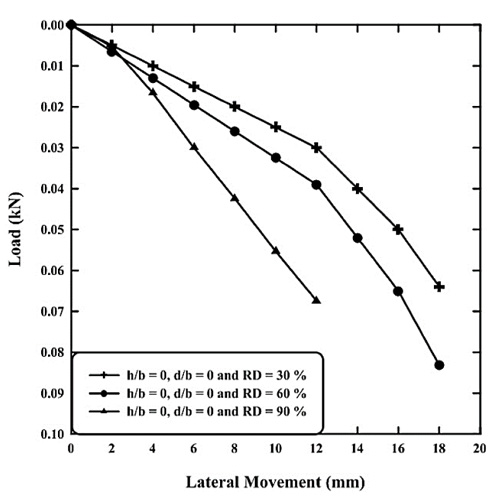 |
Fig. (2). The load-horizontal movement for unskirted footing. |
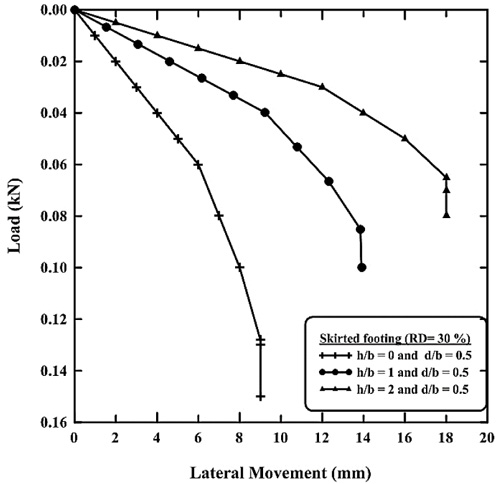 |
Fig. (3). The load-horizontal movement for skirted footing for different values of (h/b) at (d/b = 0.5 and RD = 30%). |
Fig. (4) shows the response of the load versus the lateral movement for skirted footing at the optimum value of (h/b = 0) and (RD = 30%) for different values of ratio (d/b). The results state that the increases in value of (d/b) lead to an increase in the bearing load and a decrease in the lateral movement.
The effect of the change in state of sandy soil from a loose to dense for skirted footing at the optimum value of (h/b = 0 and d/b = 2) are displayed in Fig. (5). The results show that the change of the soil state from loose to medium to dense led to increases in bearing load and reduction in horizontal movement; in other words, the state of soil has an effect on the bearing load and lateral movement with a ratio value of h/b and d/b, especially when (h/b ˂ 1), and the state of soil has no effect on the bearing load and lateral movement when the value of b/h ˃ 1.
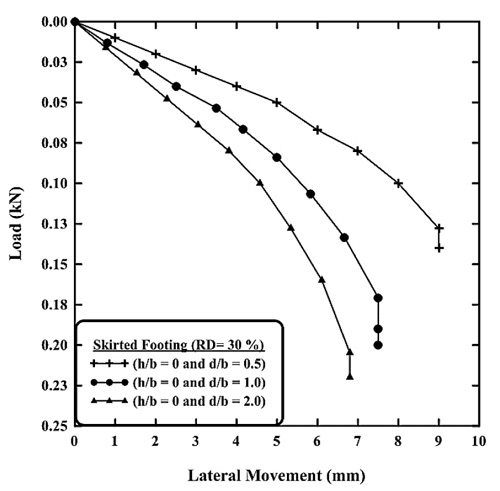 |
Fig. (4). The load-horizontal movement for skirted footing for different values of (d/b) at (h/b = 0 and RD = 30%). |
 |
Fig. (5). The load-horizontal movement for skirted footing for different values of relative density at (h/b = 0 and d/b = 2). |
Figs. 6 and 7 show the load response of the lateral movement at different values of (h/b) at (d/b = 0.5) and (RD = 60% and 90%), respectively. The figures show the same behavior of increases in load bearing and reduction in lateral movement, with decreases in the ratio of (h/b) and the optimum value of (h/b) equal to zero, which means the wall coincides with the edge of the footing.
Fig. (8) illustrates the effect of change on the ratio of (h/b) on maximum load capacity at (d/b = 0.5) and the state of sand changing from loose to medium to dense. The figure shows the maximum bearing load when (b/h = 0) and the maximum load increase to 0.15, 0.20, and 0.24 with changes in the relative density of sand from 30, 60, and 90%; in other words, the percent increase in maximum load is about 1.3 and 1.6 for a change in the state of soil from loose (RD = 30%) to medium to dense (60 and 90%), respectively.
 |
Fig. (6). The load-horizontal movement for skirted footing for different values (h/b) at (d/b = 0.5 and RD = 60%). |
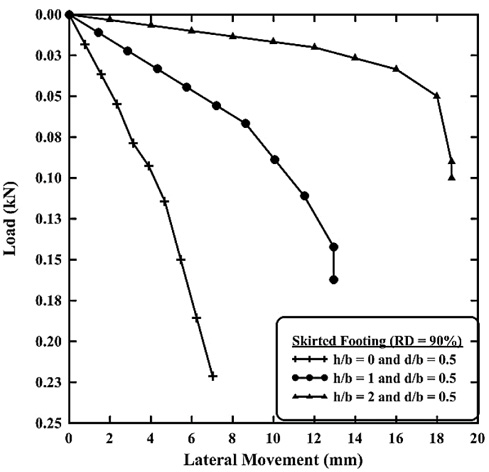 |
Fig. (7). The load-horizontal movement for skirted footing for different values (h/b) at (d/b = 0.5 and RD = 90%). |
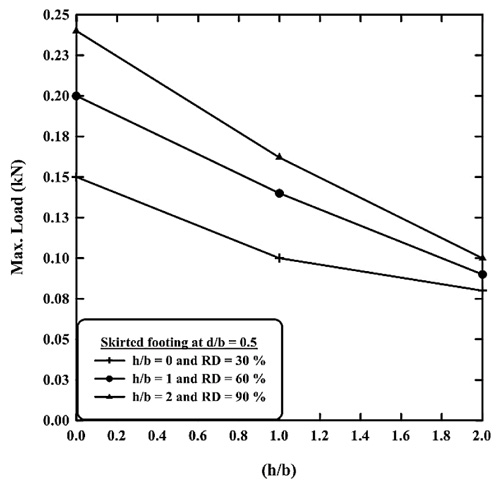 |
Fig. (8). The maximum load versus (b/h) ratio for different values of relative density at (d/b = 0.5). |
Fig. (9) illustrates the effect of change of the ratio of (h/b) on the maximum movement at (d/b = 0.5) and the state of sand changing from loose to medium to dense. The figure shows the maximum reduction in lateral movement when (b/h = 0) and the maximum reduction in movement is 9.0, 7.9, and 7.0 mm with a change in the relative density of sand from 30, 60 and 90%; in other words, the percentage of reduction in maximum lateral movement (Rs%) is defined as:
 |
(1) |
where:
S* = the lateral movement at (RD = 60 and 90%)
S = the lateral movement at (RD = 30%)
The maximum reduction in lateral movement is about 12 and 23% for a change in the state of soil from loose (RD = 30%) to medium to dense (60 and 90%), respectively.
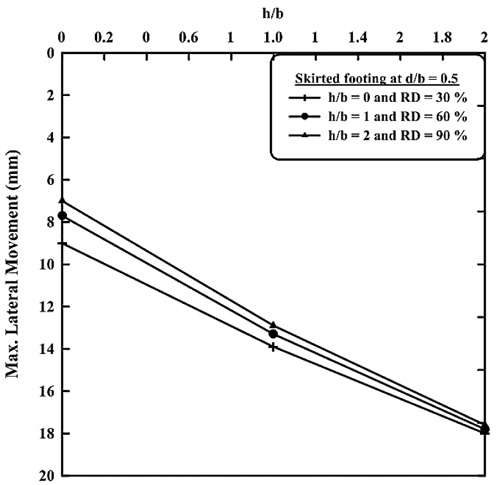 |
Fig. (9). The maximum lateral movement versus (b/h) ratio for different values of relative density at (d/b = 0.5). |
CONCLUSION
- In general, the presence of a wall behind footing (skirted footing) leads to increases in bearing load and a reduction in the lateral movement compared with unskirted footing.
- The presence of a wall near or coinciding with the footing (h/b = 0) leads to maximum increases in bearing load and a reduction in the lateral movement for skirted footing.
- The value of the ratio (h/b) becomes ineffective when the value is greater than one (h/b ˃ 1).
- Increases in the value of the ratio of (d/b) lead to increases in the bearing load and a reduction in the lateral movement.
- The state of soil influences the bearing load and lateral movement with a ratio value of (h/b and d/b), especially when (h/b ˂ 1) and the state of the soil has no effect on the bearing load and lateral movement with a ratio value of (h/b ˃ 1).
CONSENT FOR PUBLICATION
Not applicable.
CONFLICT OF INTEREST
The authors declare no conflict of interest, financial or otherwise.
ACKNOWLEDGEMENTS
Declared none.



